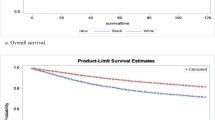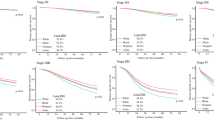Abstract
Background
Although the United States (US) Hispanic population consists of diverse communities, prior breast cancer studies often analyze this group in aggregate. Our aim was to identify differences in breast cancer stage at presentation in the US population, with a particular focus on Hispanic subgroups.
Methods
Data from the National Cancer Database (NCDB) from 2004 to 2017 were used to select women with primary breast cancer; individuals were disaggregated by racial and ethnic subgroup and Hispanic country of origin. Ordinal logistic regression was used to create adjusted odds ratios (aORs) with 95% confidence intervals (CIs), with higher odds representing presentation at later-stage breast cancer. Subgroup analysis was conducted based on tumor receptor status.
Results
Overall, among 2,282,691 women (5.2% Hispanic), Hispanic women were more likely to live in low-income and low-educational attainment neighborhoods, and were also more likely to be uninsured. Hispanic women were also more likely to present at later-stage primary breast cancer when compared with non-Hispanic White women (aOR 1.19, 95% CI 1.18–1.21; p < 0.01). Stage disparities were demonstrated when populations were disaggregated by country of origin, particularly for Mexican women (aOR 1.55, 95% CI 1.51–1.60; p < 0.01). Disparities worsened among both racial and country of origin subgroups in women with triple-negative disease.
Conclusion
Later breast cancer stage at presentation was observed among Hispanic populations when disaggregated by racial subgroup and country of origin. Socioeconomic disparities, as well as uncaptured disparities in access and/or differential care, may drive these observed differences. Future studies with disaggregated data are needed to characterize outcomes in Hispanic communities and develop targeted interventions.

Similar content being viewed by others
References
Sung H, Ferlay J, Siegel RL, et al. Global Cancer Statistics 2020: GLOBOCAN estimates of incidence and mortality worldwide for 36 cancers in 185 countries. CA Cancer J Clin. 2021;71(3):209–49. https://doi.org/10.3322/caac.21660.
Lantz PM, Mujahid M, Schwartz K, et al. The influence of race, ethnicity, and individual socioeconomic factors on breast cancer stage at diagnosis. Am J Public Health. 2006;96(12):2173–8. https://doi.org/10.2105/AJPH.2005.072132.
Champion CD, Thomas SM, Plichta JK, et al. Disparities at the intersection of race and ethnicity: examining trends and outcomes in hispanic women with breast cancer. JCO Oncol Pract. 2022;18(5):e827–38. https://doi.org/10.1200/OP.20.00381.
Ooi SL, Martinez ME, Li CI. Disparities in breast cancer characteristics and outcomes by race/ethnicity. Breast Cancer Res Treat. 2011;127(3):729–38. https://doi.org/10.1007/s10549-010-1191-6.
El Saghir NS, Seoud M, Khalil MK, et al. Effects of young age at presentation on survival in breast cancer. BMC Cancer. 2006;6(1):194. https://doi.org/10.1186/1471-2407-6-194.
3 ways that the U.S. population will change over the next decade. PBS NewsHour. Published 2 January 2020. https://www.pbs.org/newshour/nation/3-ways-that-the-u-s-population-will-change-over-the-next-decade. Accessed 14 Jan 2022.
US Census Bureau. 2019 Population Estimates by Age, Sex, Race and Hispanic Origin. Census.gov. https://www.census.gov/newsroom/press-kits/2020/population-estimates-detailed.html. Accessed 29 Oct 2021.
American Cancer Society. Cancer Facts & Figures for Hispanic and Latino People. American Cancer Society. https://www.cancer.org/research/cancer-facts-statistics/hispanics-latinos-facts-figures.html. Accessed 15 Nov 2021.
Escarce JJ, Kapur K. Access to and Quality of Health Care. In: Tienda M, Mitchell F (eds). Hispanics and the future of America. National Academies Press (US); 2006. https://www.ncbi.nlm.nih.gov/books/NBK19910/. Accessed 29 Oct 2021.
Becerra BJ, Arias D, Becerra MB. Low health literacy among immigrant hispanics. J Racial Ethn Health Disparities. 2017;4(3):480–3. https://doi.org/10.1007/s40615-016-0249-5.
Sheppard VB, Williams KP, Wang J, Shavers V, Mandelblatt JS. An examination of factors associated with healthcare discrimination in latina immigrants: the role of healthcare relationships and language. J Natl Med Assoc. 2014;106(1):15–22. https://doi.org/10.1016/S0027-9684(15)30066-3.
Keisler-Starkey K, Bunch LN. Health Insurance Coverage in the United States: 2019. US Census Bureau; 2020. pp. 60-271.
Banegas MP, Li CI. Breast cancer characteristics and outcomes among Hispanic Black and Hispanic White women. Breast Cancer Res Treat. 2012;134(3):1297–304. https://doi.org/10.1007/s10549-012-2142-1.
Li CI, Malone KE, Daling JR. Differences in breast cancer hormone receptor status and histology by race and ethnicity among women 50 years of age and older. Cancer Epidemiol Biomark. 2002;11(7):601–7.
Elledge RM, Clark GM, Chamness GC, Osborne CK. Tumor biologic factors and breast cancer prognosis among white, Hispanic, and black women in the United States. J Natl Cancer Inst. 1994;86(9):705–12. https://doi.org/10.1093/jnci/86.9.705.
DeSantis CE, Ma J, Gaudet MM, et al. Breast cancer statistics, 2019. CA Cancer J Clin. 2019;69(6):438–51. https://doi.org/10.3322/caac.21583.
About the National Cancer Database. American College of Surgeons. https://www.facs.org/quality-programs/cancer/ncdb/about. Accessed 29 Oct 2021.
Meghani SH, Chittams J. Controlling for socioeconomic status in pain disparities research: all-else-equal analysis when “all else” is not equal. Pain Med Malden Mass. 2015;16(12):2222–5. https://doi.org/10.1111/pme.12829.
Nuru-Jeter AM, Michaels EK, Thomas MD, Reeves AN, Thorpe RJ, LaVeist TA. Relative roles of race versus socioeconomic position in studies of health inequalities: a matter of interpretation. Annu Rev Public Health. 2018;39:169–88. https://doi.org/10.1146/annurev-publhealth-040617-014230.
VanderWeele TJ, Robinson WR. On the causal interpretation of race in regressions adjusting for confounding and mediating variables. Epidemiol Camb Mass. 2014;25(4):473–84. https://doi.org/10.1097/EDE.0000000000000105.
Siegel RL, Fedewa SA, Miller KD, et al. Cancer statistics for Hispanics/Latinos, 2015. CA Cancer J Clin. 2015;65(6):457–80. https://doi.org/10.3322/caac.21314.
Timmins CL. The impact of language barriers on the health care of Latinos in the United States: a review of the literature and guidelines for practice. J Midwif Womens Health. 2002;47(2):80–96. https://doi.org/10.1016/s1526-9523(02)00218-0.
Weinick RM, Jacobs EA, Stone LC, Ortega AN, Burstin H. Hispanic healthcare disparities: challenging the myth of a monolithic Hispanic population. Med Care. 2004;42(4):313–20. https://doi.org/10.1097/01.mlr.0000118705.27241.7c.
Ramirez AG, Talavera GA, Villarreal R, et al. Breast cancer screening in regional Hispanic populations. Health Educ Res. 2000;15(5):559–68. https://doi.org/10.1093/her/15.5.559.
Batalova JBJL and J. South American Immigrants in the United States. migrationpolicy.org. Published 15 February 2022. https://www.migrationpolicy.org/article/south-american-immigrants-united-states. Accessed 29 June 2022.
Batalova J, Babich E. Central American Immigrants in the United States. migrationpolicy.org. Published 6 August 2021. https://www.migrationpolicy.org/article/central-american-immigrants-united-states. Accessed 29 June 2022.
James G. Latinx Great Migrations—Migration History 1850-2017. University of Washington—The Great Depression in Washington State Project. https://depts.washington.edu/moving1/latinx_migration.shtml. Accessed 14 Jan 2022.
Dee EC, Chen S, Santos PMG, Wu SZ, Cheng I, Gomez SL. Anti-Asian American Racism: a wake-up call for population-based cancer research. Cancer Epidemiol Biomark Prev. 2021;30(8):1455–8. https://doi.org/10.1158/1055-9965.EPI-21-0445.
Jain B, Ng K, Santos PMG, et al. Prostate cancer disparities in risk group at presentation and access to treatment for Asian Americans, Native Hawaiians, and Pacific Islanders: a study with disaggregated ethnic groups. JCO Oncol Pract. 2022;18(1):e204–18. https://doi.org/10.1200/OP.21.00412.
Stern MC. Prostate cancer in US Latinos: what have we learned and where should we focus our attention. In: Ramirez AG, Trapido EJ (eds). Advancing the science of cancer in Latinos. Springer; 2020. pp. 57–67. https://doi.org/10.1007/978-3-030-29286-7_5
Stern MC, Fejerman L, Das R, et al. Variability in cancer risk and outcomes within US Latinos by national origin and genetic ancestry. Curr Epidemiol Rep. 2016;3:181–90. https://doi.org/10.1007/s40471-016-0083-7.
Andrulis DP, Brach C. Integrating literacy, culture, and language to improve health care quality for diverse populations. Am J Health Behav. 2007;31(Suppl 1):S122–33. https://doi.org/10.5555/ajhb.2007.31.supp.S122.
Dominguez K, Penman-Aguilar A, Chang MH, et al. Vital signs: leading causes of death, prevalence of diseases and risk factors, and use of health services among Hispanics in the United States—2009–2013. Morb Mortal Wkly Rep. 2015;64(17):469–78.
Lavizzo-Mourey RJ, Besser RE, Williams DR. Understanding and mitigating health inequities—past, current, and future directions. NEJM. https://doi.org/10.1056/NEJMp2008628. Accessed 5 Jan 2022.
LaVeist-Ramos TA, Galarraga J, Thorpe RJ, Bell CN, Austin CJ. Are black Hispanics black or Hispanic? Exploring disparities at the intersection of race and ethnicity. J Epidemiol Community Health. 2012;66(7):e21. https://doi.org/10.1136/jech.2009.103879.
Racism is a Public Health Crisis. https://www.apha.org/topics-and-issues/health-equity/racism-and-health/racism-declarations. Accessed 3 Nov 2021.
Funding
Brandon A. Mahal is funded by the Prostate Cancer Foundation (PCF), the American Society for Radiation Oncology (ASTRO), the Department of Defense, and the Sylvester Comprehensive Cancer Center. Idalid Franco is funded in part through a Diversity Supplement from the Center to Reduce Cancer Health Disparities, National Cancer Institute, National Institutes of Health. Edward Christopher Dee, Kaitlyn Lapen, and Fumiko Chino are funded in part through NIH/NCI Support Grant P30 CA008748.
Author information
Authors and Affiliations
Contributions
Nishwant Swami, Edward Christopher Dee, and Fumiko Chino had full access to all the data and had final responsibility for the decision to submit this article for publication. Concept and Design: All authors. Acquisition, analysis, and interpretation of data: All authors. Drafting of the manuscript: Nishwant Swami, Tiffany Nguyen, and Edward Christopher Dee. Critical revision of the manuscript for important intellectual content: All authors. Statistical analysis: Nishwant Swami and Edward Christopher Dee.
Corresponding author
Ethics declarations
Disclosures
Narjust Duma has provided consulting/advisory services for Pfizer, Merck, BMS, AstraZeneca, Genentech, Neogenomics, Janssen, BI Oncology, and Inivata. Nishwant Swami, Tiffany Nguyen, Edward Christopher Dee, Idalid Franco, Yefri A. Baez, Kaitlyn Lapen, Lora Wang, Neha Goel, Brandon A. Mahal, Oluwadamilola M. Fayanju, and Fumiko Chino have no conflicts of interest to declare relevant to this submission.
Additional information
Publisher's Note
Springer Nature remains neutral with regard to jurisdictional claims in published maps and institutional affiliations.
Supplementary Information
Below is the link to the electronic supplementary material.
Rights and permissions
Springer Nature or its licensor holds exclusive rights to this article under a publishing agreement with the author(s) or other rightsholder(s); author self-archiving of the accepted manuscript version of this article is solely governed by the terms of such publishing agreement and applicable law.
About this article
Cite this article
Swami, N., Nguyen, T., Dee, E.C. et al. Disparities in Primary Breast Cancer Stage at Presentation Among Hispanic Subgroups. Ann Surg Oncol 29, 7977–7987 (2022). https://doi.org/10.1245/s10434-022-12302-9
Received:
Accepted:
Published:
Issue Date:
DOI: https://doi.org/10.1245/s10434-022-12302-9




